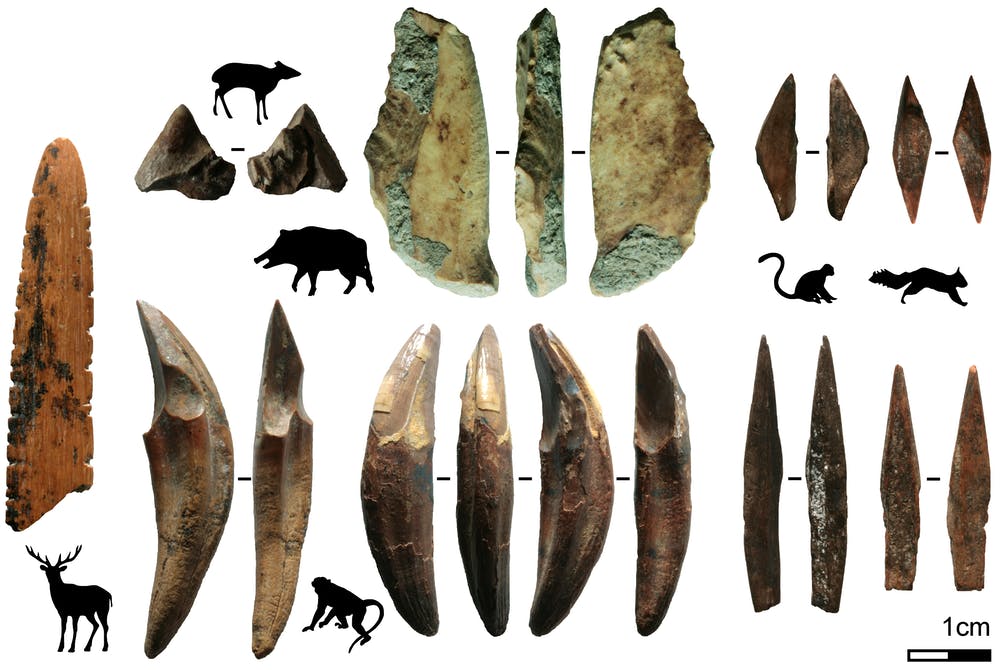Skip to comments.
Oldest Arrowheads Outside of Africa Have Been Found in The Rainforests of Sri Lanka
sciencealert.com ^
| 13 JUNE 2020
| MICHELLE LANGLEY, OSHAN WEDAGE AND PATRICK ROBERTS
Posted on 06/15/2020 10:35:56 AM PDT by BenLurkin
At Fa-Hien Lena, a cave in the heart of Sri Lanka's wet zone forests, we discovered numerous tools made of stone, bone, and tooth – including a number of small arrow points carved from bone which are about 48,000 years old.
The invention of the bow and arrow allowed people to hunt prey at a much greater distance. People no longer had to get within "a stone's throw" of prey which could suddenly bolt and escape. This innovation greatly increased the chances of a successful hunt.
Bows and arrows also made it much safer to hunt dangerous prey. If you don't have to get too close, you're less likely to be trampled or mauled by a hurt and angry animal
(Excerpt) Read more at sciencealert.com ...
TOPICS: History
KEYWORDS: arrowheads; ceylon; fahienlena; godsgravesglyphs; huntergatherers; srilanka
1
posted on
06/15/2020 10:35:56 AM PDT
by
BenLurkin
To: SunkenCiv
 Bone technology of Fa-Hien Lena. (M. C. Langley)
Bone technology of Fa-Hien Lena. (M. C. Langley)
Above: Tools made from bone and teeth of monkeys and smaller mammals recovered from Fa-Hien Lena, Sri Lanka. This technology included small bone arrow points (bottom right), and skin or plant-working tools.
2
posted on
06/15/2020 10:37:33 AM PDT
by
BenLurkin
(The above is not a statement of fact. It is either opinion or satire. Or both.)
To: BenLurkin
If I were on a boat passing by Sri Lanka 48,000 years ago, I would be tempted to simply Ceylon.
3
posted on
06/15/2020 10:42:28 AM PDT
by
chajin
("There is no other name under heaven given among people by which we must be saved." Acts 4:12)
To: chajin
4
posted on
06/15/2020 10:43:56 AM PDT
by
BenLurkin
(The above is not a statement of fact. It is either opinion or satire. Or both.)
To: BenLurkin
It is amazing that you can still read the date of manufacture on these bones.
5
posted on
06/15/2020 11:21:40 AM PDT
by
mountainlion
(Live well for those that did not make it back.)
To: BenLurkin
Interesting article and ‘points’.
Arrow and spear heads near me in Colorado have been dated to about 11,000 years ago (Folsom points). A friend in Arkansas took one he found there to a professor to who said it was about that same vintage.
6
posted on
06/15/2020 11:52:46 AM PDT
by
SaxxonWoods
(Just sit in your house until the food stops coming and then starve. You'll be safe.)
To: chajin
7
posted on
06/15/2020 12:01:40 PM PDT
by
ptsal
(Vote R.E.D. >>>Remove Every Democrat ***)
To: StayAt HomeMother; Ernest_at_the_Beach; 1ofmanyfree; 21twelve; 24Karet; 2ndDivisionVet; 31R1O; ...
Thanks BenLurkin. Interesting tidbit in the version of the story I'd read but never got 'round to posting -- the oldest known anatomically modern [sic] human fossils were excavated in Sri Lanka.

8
posted on
06/15/2020 3:33:21 PM PDT
by
SunkenCiv
(Imagine an imaginary menagerie manager imagining managing an imaginary menagerie.)
To: BenLurkin; SunkenCiv
Forgive me if you’ve posted articles on it already, but does this discovery tie in to the “fish hook” theory of human brain development via fatty acids (DHA)?
9
posted on
06/15/2020 4:12:22 PM PDT
by
nicollo
(I said no!)
To: nicollo
10
posted on
06/15/2020 4:24:07 PM PDT
by
SunkenCiv
(Imagine an imaginary menagerie manager imagining managing an imaginary menagerie.)
To: chajin
11
posted on
06/15/2020 5:10:37 PM PDT
by
SunkenCiv
(Imagine an imaginary menagerie manager imagining managing an imaginary menagerie.)
To: mountainlion
Well, if you know how to read the serial number it is all right there.
To: SunkenCiv
Must have been a very powerful bow to launch an arrow all the way to Sri Lanka from Africa..........must have used a compound bow......................
13
posted on
06/16/2020 5:07:24 AM PDT
by
Red Badger
(Always trust God............but wash your hands......................)
To: chajin
I see what you did there........................
14
posted on
06/16/2020 5:14:32 AM PDT
by
Red Badger
(Always trust God............but wash your hands......................)
To: Red Badger
15
posted on
06/16/2020 7:22:47 AM PDT
by
SunkenCiv
(Imagine an imaginary menagerie manager imagining managing an imaginary menagerie.)
https://pubmed.ncbi.nlm.nih.gov/3111269/
Am J Phys Anthropol. 1987 Apr;72(4):441-61. doi: 10.1002/ajpa.1330720405.
Upper Pleistocene Fossil Hominids From Sri Lanka
K A Kennedy, S U Deraniyagala, W J Roertgen, J Chiment, T Disotell
PMID: 3111269 DOI: 10.1002/ajpa.1330720405
Abstract
Between 1978 and 1983 hominid skeletal remains were collected from the cave sites of Batadomba lena and Beli lena Kitulgala in Sri Lanka (formerly Ceylon). These are the most ancient specimens of anatomically modern Homo sapiens found thus far in South Asia, radiocarbon dates placing them in the Upper Pleistocene. Morphometric analysis of the remains of some 38 individuals from the two sites indicates that these populations were characterized by medium stature, moderate to pronounced cranial and postcranial robusticity, medium-size permanent tooth crown measurements, prognathic alveolar facial proportions, and low incidence of osseous and dental pathological conditions. Comparisons of these ancient Sri Lankans with other prehistoric skeletal series from South Asia and elsewhere support the hypothesis that muscular-skeletal robusticity was a significant physical adaptation of earlier hunting-foraging populations. A trend towards reduction of sexual dimorphism and development of more gracile body form and smaller teeth appears to have accelerated with the socioeconomic transition to food-production strategies involving agriculture and pastoralism and refinement of technologies for food procurement and preparation, as documented by morphometric studies of later prehistoric inhabitants of South Asia.
16
posted on
07/01/2020 7:22:02 PM PDT
by
SunkenCiv
(Imagine an imaginary menagerie manager imagining managing an imaginary menagerie.)
Disclaimer:
Opinions posted on Free Republic are those of the individual
posters and do not necessarily represent the opinion of Free Republic or its
management. All materials posted herein are protected by copyright law and the
exemption for fair use of copyrighted works.
FreeRepublic.com is powered by software copyright 2000-2008 John Robinson


